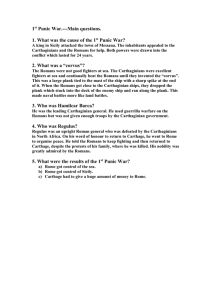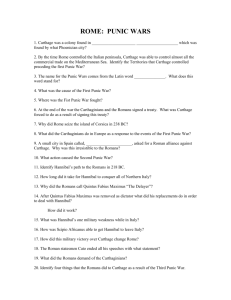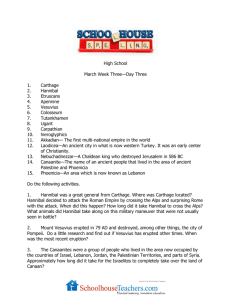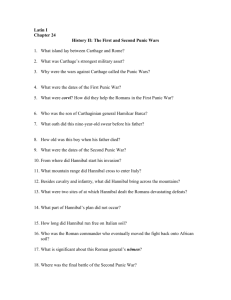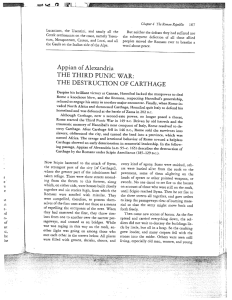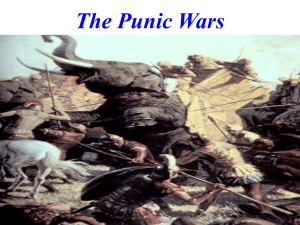Information
advertisement
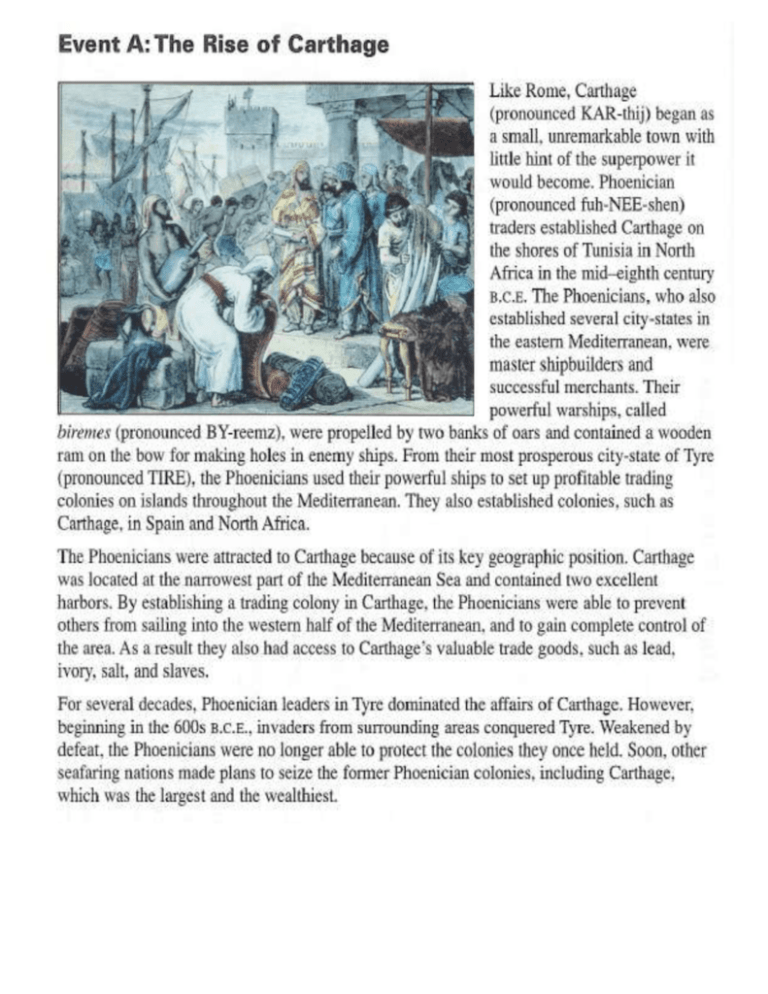
Following the collapse of Phoenician power, wealthy Carthaginian merchants and landowners established an oligarchic republic in the former colony. A Council of Four Hundred, similar to the Roman Senate, followed a policy designed to produce wealth through trade. To protect themselves and acquire new territories, the new leaders of Carthage created an enormous navy. The Carthaginian navy was particularly famous for the quinquereme (pronounced KWIN-kwah-REEM), a one-deck ship with about 50 or 60 oars, five (quinque) men to an oar. Although the quinquereme was heavier and slower than most ships, it was most effective at ramming enemy ships. With their powerful navy, the Carthaginians seized control of the former Phoenician colonies. By 264 B.C.E., they controlled all of North Africa, Corsica, Sardinia, parts of Sicily, the Balearic Islands, eastern Spain, and the Strait of Gibraltar. With the control of such vast territories, Carthage became a superpower and seemed to have an advantage over Rome. The city of Carthage had a population of 100,000 to 200,000 people compared with Rome's population of 50,000 to 75,000. The city was three times as large as Rome and far more impressively laid out. Carthage could boast of a splendid harbor, spacious markets, busy manufacturing quarters, and beautiful homes for the wealthy - all surrounded by a massive protective wall. The city of Rome, on the other hand, was moderate in size, dirty, and contained few large stone buildings. Furthermore, the Carthaginians had access to a population of 1.5 million people through their colonies and allies. In contrast, the Romans and their subject people numbered less than one million. Still the Romans confidently believed that their well-trained soldiers could resist Carthaginian aggression, and they exercised their military power on land. In his Histories, the ancient Greek writer Polybius (puh-LEE-bee-uss) summarized the standoff between the two powers on the eve of the Punic Wars: "As the Carthaginians maintained without any trouble the command of the sea, the fortunes of the war continued to hang in the balance." After four years of fighting, the Romans decided the only way to drive the Carthaginians out of Sicily was to build their own fleet of ships. In 264 B.C.E. the Romans captured a Carthaginain quinquereme (warship) in battle. Roman engineers carefully studied the design, and then used what they had learned to construct 140 ships in the astonishingly short time of 60 days. The Romans also added a new feature to the ships they built, called a corvus (pronounced KOR-vuss) - a wooden gangway with a spike on the end. The corvus stood in an upright position until the Roman ship came next to the enemy ship. Then, the plank was lowered onto the other ship, the spike secured it, and well-trained Roman soldiers rushed across the gangway onto the enemy ship to slaughter the Carthaginian sailors. After building their warships, the Romans enjoyed several victories. Soon, thereafter, however, they began to suffer horrendous reversals. First, they lost almost 30,000 men in an attempt to invade North Africa. Next, their fleets were caught in several severe storms. The corvuses made the ships top heavy, and they capsized in heavy seas. Roman casualties totaled more than 700 lost ships and 200,000 dead sailors. In addition, the Carthaginians appointed an extremely able commander, Hamilcar Barca, to lead their troops. Hamilcar defeated a number of Roman fleets and conducted raid along the Roman and Sicilian coasts. These victories, which were often the result of his ability to quickly outflank his enemy, earned Hamilcar the nickname "Man of Lightening." By 245 B.C.E., after 20 years of fighting, Rome's treasury was empty and its people were exhausted. Nevertheless, Roman citizens donated their private wealth to build one final fleet of 200 ships that wisely did not contain the corvus. The strategy paid off, and in a final naval battle off the Sicilian coast, the Roman navy sank 50 Carthaginian ships and captured 70 others. Carthage could no longer supply her troops in Sicily and sued for peace. According to Polybius, the initial terms for peace presented to Carthage included the following: "The Carthaginians [are] to evacuate the whole of Sicily...[and] to give up to the Romans all prisoners without ransom. The Carthaginians [are] to pay the Romans by installments in twenty years 2,200 talents." This was an enormous sum of money in Roman currency. Later, vengeful members of the Roman Senate increased the fine to 3,200 talents and reduced the payment period to 10 years. In addition, they stipulated that Carthaginians quinqueremes were forbidden to sail in Roman waters. The Carthaginians were in no position to challenge these changes and accepted the treaty. Thus, the First Punic War came to an end in 241 B.C.E. To reach Italy, Hannibal decided to lead his army over the towering, snow-capped Alps. Wasting no time, he quickly led his army of 40,000 infantry, 6,000 cavalry, and 37 elephants out of Spain before the Romans could trap him there. Because the population of Carthaginian citizens was small, most of Carthage's army was made up of mercenaries drawn from Africa, Spain, Gaul, and Phoenicia. However, despite its diverse composition, the army never mutinied against Hannibal, and most of the men expected to make it across the Alps and win glory in Italy. Despite the tremendous challenges involved in transporting elephants over the Alps, Hannibal decided to bring them, according to Polybius, "because enemies were so terrified of the animal's strange appearance that they dared not come anywhere near them. To move a small group over the Alps would have been difficult, but to move an entire army required tremendous leadership skills. Rocks often blocked Hannibal's path, and mountain tribes ambushed the army. Many men and animals slipped thousands of feet to their deaths. As a result of these hardships, the soldiers often grew frightened and pessimistic. To boost morale, Hannibal frequently gathered his men together and made passionate speeches. Hannibal's actual words were never recorded, but the Roman historian Livy later offered his version of the inspiring lines Hannibal may have used in his pep talks: "What toils andperils you went through for eight months to capture Saguntum! And now that Rome, the capital of the world, is your goal, can you deem anything so difficult or arduous that it should prevent you from reaching it?" After five grueling months, Hannibal's army finally crossed the Alps and entered the Po Valley in northern Italy. His forces now numbered less than 26,000 infantry, 4,000 cavalry, and 20 elephants. Two tribes from northern Italy, who were already at war with Rome, eargerly joined Hannibal's army and made up for the men he had lost. After a short rest, Hannibal quickly defeated a Roman army and began his assault on the Italian peninsula. Upon his return to North Africa, Hannibal spent several months preparing for Scipio's inevitable attack on the city of Carthage. He recruited as many soldiers as he could, and by 202 B.C.E. had a force of 40,000 soldiers and 80 elephants. Seeking to learn more about Scipio's forces, Hannibal sent three spies into the Roman camp, which was located near Zama, a plain about 75 miles southwest of Carthage. The spies were captured by the Romans but were returned to Hannibal unharmed. Scipio felt this move would deal an unexpected blow to Carthaginian morale. It would show that he was unconcerned about whether Hannibal knew important details about the Roman forces. Hannibal was so impressed with this bold action that he requested a meeting with Scipio. According to Livy, "Keeping their armed men at the same distance the generals...spoke at some length...[and concluded] that arms must decide the issue and [that] they must accept whatever lot the Gods [gave] them." The day after their dramatic encounter, Hannibal and Scipio led their armies into battle at Zama. At first, the Carthaginians were able to hold their own against the larger, better-trained Roman army. However, when a strong cavalry attack hit Hannibal's forces from the rear, the tide of the battle turned. Although Hannibal managed to escape, the slaughter was horrific. Polybius wrote later that "the Romans were hindered by the quantity of slippery corpses which were still soaked in blood and had fallen in heaps and the number of arms thrown away haphazard." Following his defeat at Zama, Hannibal himself advised Carthage to establish a peace treaty with Rome, although he realized the terms of the treaty would be harsh for Carthage. In 201 B.C.E. Roman ambassadors arrived at Carthage and presented harsh terms similar to those at the end of the First Punic War. However, this time Carthage was compelled to give up all her interests in Spain and the Mediterranean islands, to surrender all their elephants, to burn all buy 10 of their warships, to pay a huge indemnity (fine) for 50 years, and to never declare war without first consulting Rome. Much to the ambassadors' surprise, Hannibal declared that the terms were not nearly as harsh as he had expected and convinced his government to accept them. The Romans did not require the Carthaginians to turn Hannibal over to them, perhaps because he was the only leader strong enough to hold Carthage together so that the indemnity could be paid. In time, however, the Romans came to fear Hannibal, and invented a charge that he was conspiring with Rome's enemies. To appease the Romans, the Carthaginians declared Hannibal an outlaw, and he fled to the Middle East, where he was pursued by Roman agents. Eventually, finding himself cornered near the coast of the Black Sea, he committed suicide. After declaring war, the Roman leaders were determined to destroy and humiliate Carthage. An army of 80,000 infantry and 4,000 cavalry was quickly assembled and sent to North Africa. Then, the Romans issued a series of cruel demands, giving the impression that they would not attack the city of Carthage if the Carthaginians accepted certain conditions. First, they insisted that the Carthaginians turn over 300 children from noble families to be used as hostages during negotiations. The Carthaginians complied, but negotiations never began, and the children were never returned. Then, the Romans demanded that all weapons and machines of war be turned over to them. Again, Carthage agreed, and surrendered arms for 100,000 men and 2,000 catapults. Still the Romans were not satisfied. They summoned the Carthaginian representatives, and announced that all citizens of Carthage would have to leave the city and rebuild 10 miles inland. This was too much. The Carthaginians refused and prepared to defend themselves. Carthaginians put up a valiant but unsuccessful effort to defend their homes. They freed all their slaves and made them citizens so as to enlist their help for the war. The rich citizens gave up all of their wealth so that the government could purchase materials to make weapons. Every open space was turned into a workshop to produce armaments. Men and women worked all day and night to produce 100 shields, 300 swords, 1,000 missiles for catapults, and 500 dars and spears. Women cut off their hair to provide fiber for ropes since no other material was available. Carthaginians held off the Romans for three years, but finally their walls were breached, and after a bloody battle, the city fell in 146 B.C.E. The Roman army torched the city, and it burned for 17 days. The ancient Greek writer, Appian, captured some of the horrors of this even in his Roman History: "The fire spread and carried everything down... many fell dead under the collapsing stones. Still others... were torn asunder into all kinds of horrible shapes, crushed and mangled." When the fire died out, the Romans tore down all remaining buildings, sowed salt into the earth so that it would never be fit for agriculture, and sold the 50,000 survivors into slavery. So complete was the destruction of Carthage that, even to this day, archaeologists have discovered only a few ancient artifacts in the area. A few tombs, some badly ruined buildings, a number of coins, and a few pieces of pottery are all that remain of this once-great civilization. No Carthaginian literature, major sculptures, artistic works, or religious temples have been uncovered.
